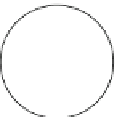Biomedical Engineering Reference
In-Depth Information
cilium membrane
radial spoke
central pair
central sheath
nexin
inner dynein arm
B−tubule
outer dynein arm
A−tubule
Fig. 12.2
Structure of the respiratory cilium. The cytoskeletal structure of the cilium is the
axoneme. The building block of the axonene is the microtubule. Each axoneme is composed
of several microtubules aligned in parallel. It is actually constituted of an array of 9 peripheral
doublets of microtubules (A- and B-tubules) and 2 central single microtubules. Each A-tubule
possesses: (1) inner and outer dynein arms that cause microtubules to slide against each other and
cilium to bend back and forth; (2) nexin linkage to adjacent microtubular doublet; and (3) radial
spoke with head close to one of the 2 single microtubules of the central sheath complex. Energy
source ATP allows active sliding of axonemal doublet microtubules.
Both plasma and ciliary membranes control the ciliary activity by regulating
the ionic environment and ATP concentration for normal enzymatic function of the
axoneme. Regulators modify the spatiotemporal pattern of the dynein-microtubule
interactions within the axoneme.
Bardet-Biedl Syndrome Proteins
Mutations in genes that generate Bardet-Biedl syndrome affect primary, sensory
cilia as well as motile cilia of the respiratory tract.
25
The BBS genes are expressed
25
The Bardet-Biedl syndrome is a rare, pleiotropic, autosomal recessive disorder with diverse man-
ifestations (obesity, hypertension, retinopathy, polydactyly, hypogenitalism, renal abnormalities,
and developmental delay) and increased incidence of asthma. It results from mutations in any of
BBS genes (BBS1-BBS12).






























































Search WWH ::

Custom Search